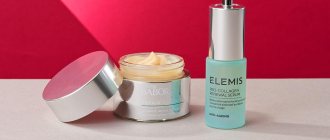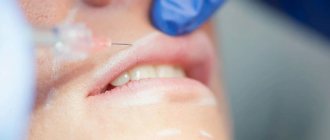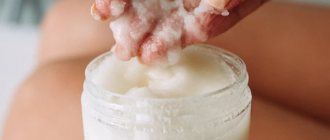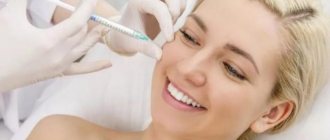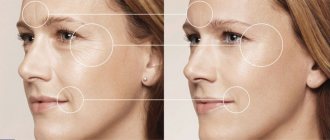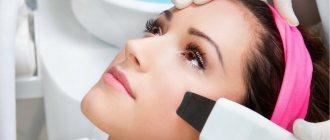Expected consequences of chemical facial peeling
During the procedure, the acids used act on the layers of the epidermis, causing the removal of keratinized particles that prevent the appearance of new cells. Therefore, after almost every chemical peel, the following points will be observed.
- Redness, or erythema , of skin that has experienced a planned burn during peeling. It can last from several hours to several days, depending on the concentration of the solution used and the depth of its effect on the epidermis. If no side effects are noted, the erythema will soon go away on its own.
- Mild burning and tingling of the skin , disappearing after a few hours, increased sensitivity to external irritants. This temporary phenomenon is a consequence of acid entering the layers of the epidermis and the process of its gradual neutralization.
- Severe tightness and dryness of the skin , accompanied by active peeling. Peeling begins after a few days and can last up to 10-14 days, depending on the type of peeling performed. The main thing here is not to interfere with the natural process and not to remove the exfoliating layer of skin mechanically. You can help your skin with moisturizing gels and creams, or Panthenol spray, which is applied to the face several times a day. They can be used one day after superficial peeling and 2-3 days after medium peeling.
- Edema . After a chemical peel, they are caused by fluid coming from the inner layers of the epidermis accumulating in the upper tissues of the skin. But if swelling persists for a long time, you should contact a specialist who will prescribe appropriate treatment and help minimize the consequences of the procedure.
- Hyperpigmentation in treated areas . During the normal course of the process, it disappears as the old layer of skin peels off and a new one appears in its place. It is enough to use the care products listed above.
- Pustular acne . After chemical peeling, this happens often and is usually a consequence of violating the cosmetologist’s recommendations. The situation can be corrected by using light gels and lotions that promote skin regeneration. If acne does not go away on its own, you need to contact a specialist: he will remove it by mechanically cleaning the face.
These are completely natural phenomena, indicating that the process of renewal of the epidermis has begun, the result of which can be seen when the skin returns to normal. So, after superficial peeling, the skin will become smooth and even, get rid of fine wrinkles and acne, and improve complexion. A greater effect can be achieved with medium peeling, which allows you to get rid of deep wrinkles, scars, acne, pigmentation, and sagging skin. The most effective, but also the most dangerous, is deep peeling, after which the skin will look noticeably younger and refreshed.
You can find out more about the service and its cost here >>
What is peeling
Exfoliation (peeling) is a procedure during which dead skin is removed from the facial skin and the surface itself is cleaned. After it, the following consequences may appear:
- peeling - from 2 to 7 days;
- redness (especially after chemical peeling) - up to 5 days;
- slight tingling or burning – up to 2 hours;
- swelling - occurs on thin skin and lasts up to 5 days.
The effect of the procedure is beneficial for the skin, as it starts regeneration processes, activates blood circulation and prevents the appearance of wrinkles. However, peeling is quite harsh, so after the procedure the skin needs to be helped to recover.
Care after deep peeling
Deep peeling with chemicals is a difficult medical procedure, which is performed exclusively for indications: for large scars and significant scars, to eliminate age-related problems or stretch marks. Care after such a procedure includes the following:
- limit contact with the external environment as much as possible - do not go outside again, do not touch your face with your hands;
- use only soft care products, such as foam;
- Do not use decorative cosmetics until the skin is completely healed.
After such a procedure, the skin’s protective barrier weakens, so the body is easily susceptible to diseases. Deep peeling is contraindicated in the following cases: chronic diseases, the entire period of pregnancy and lactation, diseases of the gastrointestinal tract, endocrine and cardiovascular systems. To reduce the likelihood of skin infection, your doctor may prescribe antibacterial agents and pain relievers.
What to do if side effects occur?
Following your esthetician's recommendations will help prevent side effects from exfoliation. But what to do if they do appear? It is necessary to immediately contact a specialist to minimize the impact of complications on the skin.
Peeling of the epidermis is considered a normal reaction. It appears on the 2nd day after exfoliation and disappears after a week. To soften and speed up the process, you can use a moisturizer with hyaluronic acid as prescribed by a cosmetologist. On the 3rd day, it is recommended to include shea and grape seed butter in your facial care. They eliminate tightness and prevent scar formation. Before using cosmetics after peeling, consult a cosmetologist to see if this can be done in your situation.
Hyperemia or redness of the epidermis is characteristic of medium and deep exfoliation. It can remain on the face for up to 2 weeks. Therefore, to the question “How many days after peeling can you go to the sauna?” you can answer: until the redness goes away. For the same reason, fitness, stress, spicy food, and alcohol are prohibited. Omega-3 acid supplements will help the body cope with this problem.
Facial swelling after exfoliation may occur in women with thin skin. Products with antioxidants will help get rid of this side effect.
Pimples should not normally appear on the face after exfoliation. Their presence indicates incorrect post-peeling care. With this problem you need to contact a cosmetologist. He will prescribe antibiotics, sebostatic, anti-inflammatory or zinc-containing drugs on an individual basis.
An allergy test, which must be done before exfoliation, will protect you from allergies. During the rehabilitation period, you need to care for your skin with hypoallergenic cosmetics. If dermatitis does occur, the doctor prescribes antihistamines.
Attention! It is forbidden to peel off the resulting crusts; this can lead to infection, the formation of a scar or scar. Aseptic care and wound healing ointments based on panthenol or retinol are needed.
Hyperpigmentation can occur if exfoliation is done in the summer without prepping with kojic and retinoic acids. If spots appear, then discard products with extracts of St. John's wort, lemon, cinnamon, clover, lavender, and bergamot.
Is it possible to go to the bathhouse and play sports after peeling?
If you have exfoliated in a beauty salon, remember an important rule: a bath after peeling is taboo. For the next 48-72 hours after exfoliation of any kind, the skin should not be exposed to elevated temperatures and steam. Not only the traditional Russian steam room is prohibited, but also the Finnish sauna, Turkish hammam, phyto-barrel and other analogues.
Many women are interested in the question “Is it possible to go to the sauna after peeling and why?” In a sauna, as in a bathhouse, body temperature rises and sweating intensifies. Particles of the active substance that was used in chemical exfoliation begin to come out of the pores along with the liquid. At the same time, the effect of the procedure is noticeably reduced. In addition to increased sweating, during a stay in a sauna or bathhouse, a person’s blood vessels dilate and the skin turns red. This process prolongs the hyperemia of the skin for a longer period of time. Therefore, when a patient asks a cosmetologist, “Is it possible to go to the steam room or bathhouse after peeling?”, the specialists answer with a firm “no.”
A specialist in outdoor activities will give approximately the same recommendations. Can I exercise after peeling? You will hear an unequivocal “no!” from experts. Active sports also provoke sweating and redness of the surface layer of the skin. This interferes with the normal process of restoration of the epidermis after injury. During the rehabilitation period, I need to refrain from baths and fitness.
Now you know the answer to the question: “Can I take a bath or go to the gym after peeling?” To quickly restore the skin and consolidate a good result, these activities should be abandoned. Spicy foods and alcohol, which cause vasodilation, are also prohibited.
Care after medium peeling
This peeling is prescribed for intense age-related problems or scars. Recovery can take from 5 to 10 days - during this period the skin becomes very red and peels. Care after medium peeling includes:
- limit contact with the external environment for the first 2-3 days;
- do not touch the crusts;
- use mild cleansers;
- Use good sun protection.
It is better to avoid physical activity, visiting baths and saunas, as well as strong cleansers and masks. An excellent option is GIGI Recovery cream, which fights inflammation and helps the skin recover.
Care after superficial peeling
At this stage, only the top layer of skin is affected. All unpleasant sensations disappear after 10 days. Formulations with glycolic, malic, tartaric, citric, lactic or phytic acids are used here.
Basics of care after superficial peeling: refrain from contact with water and direct sunlight for 24 hours, avoid touching your face, reduce time spent outside, drink plenty of fluids. You can also use light mousses and foams, and decorative cosmetics can be introduced as early as day 4. For better recovery, it is recommended to use the GIGI Vitamin E mask.
General recommendations from cosmetologists
In order to reduce the negative impact of external environmental factors, as well as not to delay the rehabilitation process, cosmetologists strongly recommend listening to their advice. First of all, they relate to the following points:
- You cannot wear makeup, use foundation or powder until the skin is completely restored after chemical peeling. Firstly, you can get an infection, and secondly, particles of decorative cosmetics and foundation will clog your pores and make your face look unkempt.
- Going to the sauna, steam bath, playing sports and performing increased physical activity after peeling is unacceptable and harmful. All these actions lead to an increase in temperature and abundant release of sweat particles, which are considered excellent carriers of infections. Plus, the expansion of blood vessels will delay the passage of facial redness. For the same reason, you will have to postpone fitness, drinking alcohol, hot and spicy foods.
- Do not wash your face in the first days after the procedure, even with plain water.
- Until the end of the rehabilitation period, use the range of products recommended by a specialist. Such products have a useful composition, a high moisturizing effect and do not irritate the skin.
- If you have the slightest suspicion of a deterioration in the condition of your facial skin after the peeling procedure, you need to go to a specialist. Self-medication is dangerous for the client’s health!
- Chemical cleanings are characterized by pronounced peeling of the integument. How many days this side effect lasts depends on the type of cleansing. However, in any case, it is forbidden to peel off the resulting film or crust. This will not speed up the recovery process, but will only lead to scars.
- Lotions, gels, and cream after peeling should not contain abrasive particles and acids, as they will damage the already burned fibers.
- Try not to touch the surface of your face with your hands, do not go to the pool until the integrity of the epidermis is completely restored, so that infection does not get inside.
Do not ignore the cosmetologist’s instructions; carefully study the rules of facial care after the procedure to reduce the risk of post-peeling complications and quickly enjoy smooth, clean and radiant skin. Only with such understanding will you achieve the perfection of covers without hassle or worry.
Summary
In order for peeling to please you with a good result, it is very important to properly rehabilitate the skin. You should definitely take medications prescribed by a cosmetologist and avoid the negative influence of external and internal stress factors. In just a short time, you will be able to enjoy firm, youthful and radiant skin.
After peeling with acids, many clients of beauty salons expect to instantly see soft, velvety skin, freshness and a healthy glow, but in return they receive a red face and active peeling of the skin. How to properly care for your face after a chemical peel to achieve the desired result as quickly as possible? What should and should not be done during a difficult recovery period for the skin?
General rules of care
Regardless of the type of peeling, after undergoing it, all patients are recommended to do the following:
- For the first 12 hours, it is better not to touch the skin with your hands, not to wash your face or apply any products, and also to avoid exposure to cold wind and direct sunlight.
- For the first 2-3 days after the procedure, it is better to use light, gentle foams and gels for washing. Creams are allowed only on day 3. It is also better to avoid contact with the external environment.
- Two weeks after the procedure, you must strictly follow the cosmetologist’s instructions - take medications, use medicinal care products. It is not recommended to visit baths and saunas or apply decorative cosmetics.
If a crust forms, you should not try to peel it off; it is better to let the skin heal on its own. The most important rule is to avoid infection, so it is recommended to keep the skin clean and not touch it with your hands. When the skin begins to heal, be sure to apply products with a high level of SPF protection before going outside. Not 15, as in standard ones, but 30, or even 50 - GIGI SPF 50 sunscreen would be an excellent option.


